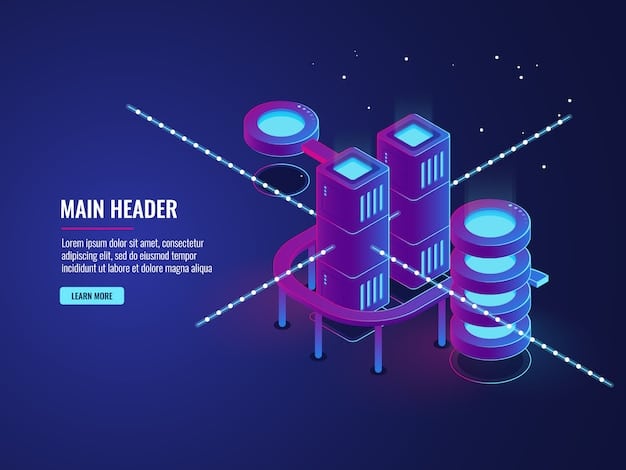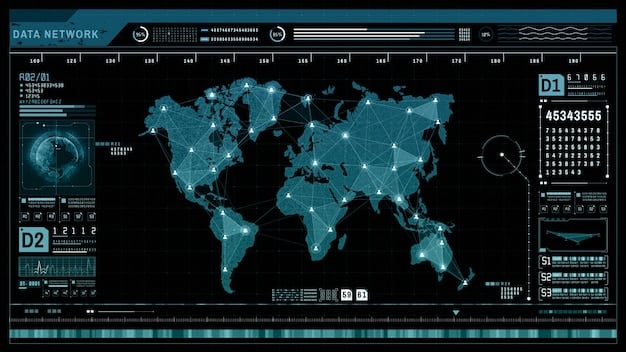US Cyber Warfare Defense: Strategies Against Foreign Threats

The United States is actively developing multifaceted strategies to counter the escalating threat of cyber warfare from foreign adversaries, including strengthening cybersecurity infrastructure, enhancing international cooperation, and adopting proactive defense measures.
The digital frontier has become a major battleground, and the US response to the growing threat of cyber warfare from foreign adversaries is a critical aspect of national security. The stakes are high, involving everything from protecting critical infrastructure to safeguarding democratic processes.
Understanding the Landscape of Cyber Threats
Cyber warfare is no longer a futuristic concept; it’s a present-day reality. Understanding the nature and scope of these threats helps shape effective responses.
Types of Cyber Threats
Cyber threats come in various forms, each with its own level of sophistication and potential impact.
- Espionage: Nation-states attempting to steal sensitive information, from military plans to trade secrets.
- Sabotage: Disrupting or destroying critical infrastructure like power grids or communication networks.
- Disinformation: Spreading propaganda and false information to manipulate public opinion and sow discord.
- Ransomware: Holding data hostage for financial gain, often targeting businesses and government agencies.
These threats are constantly evolving, requiring continuous adaptation and innovation in defense strategies.
Key Adversaries and Their Capabilities
Several nations and non-state actors pose significant cyber threats to the US. Identifying these adversaries and understanding their capabilities is essential for effective defense.
- Russia: Known for sophisticated cyber espionage and disinformation campaigns.
- China: Focused on intellectual property theft and economic espionage.
- Iran: Increasingly aggressive in its cyber activities, targeting critical infrastructure.
- North Korea: Using cyberattacks to generate revenue and disrupt adversaries.
These adversaries possess advanced technical skills and resources, making them formidable opponents in the cyber domain.
In conclusion, understanding the diverse landscape of cyber threats and the capabilities of key adversaries is paramount for the US to develop and implement effective defense strategies.
Strengthening Cybersecurity Infrastructure
One of the primary responses to cyber warfare involves fortifying the nation’s cybersecurity infrastructure. This requires a multi-faceted approach, from upgrading technology to enhancing human capital.

The US government and private sector are collaborating to improve cybersecurity across various sectors.
Upgrading Federal Systems
Federal agencies are vulnerable to cyberattacks, necessitating continuous upgrades and improvements to their IT systems.
- Implementing zero-trust architecture, which assumes no user or device is trustworthy by default.
- Adopting advanced threat detection and response systems.
- Conducting regular security audits and penetration testing.
These measures help ensure that federal systems are resilient against evolving cyber threats.
Public-Private Partnerships
Given that much of the nation’s critical infrastructure is privately owned, public-private partnerships are crucial for cybersecurity.
- Establishing information-sharing platforms to exchange threat intelligence.
- Conducting joint exercises to test and improve incident response capabilities.
- Providing incentives for companies to adopt best practices in cybersecurity.
Such partnerships foster a collaborative environment where resources and expertise are pooled to enhance overall cybersecurity.
In conclusion, strengthening cybersecurity infrastructure through federal system upgrades and public-private partnerships is essential for mitigating the risks of cyber warfare.
Enhancing International Cooperation
Cyber threats are global in nature, making international cooperation a vital component of the US response. Collaborating with allies and partners can enhance threat detection, attribution, and response capabilities.
The US is actively working with international partners to promote cybersecurity and combat cybercrime.
Cybersecurity Alliances
Forming alliances with like-minded nations allows for coordinated action against cyber threats.
- Sharing threat intelligence and best practices.
- Conducting joint cyber exercises.
- Developing common standards and norms for cyberspace.
These alliances enhance the collective ability to deter and respond to cyberattacks.
Diplomacy and Deterrence
Diplomatic efforts can help deter malicious cyber activities by establishing consequences for such actions.
- Imposing sanctions on individuals and entities involved in cyberattacks.
- Publicly attributing cyberattacks to specific nation-states.
- Negotiating international agreements to limit cyber weapons and activities.
These diplomatic measures aim to hold adversaries accountable and discourage future attacks.
In conclusion, enhancing international cooperation through cybersecurity alliances and diplomatic efforts is crucial for addressing the global nature of cyber threats.
Adopting Proactive Defense Measures
In addition to strengthening defenses, the US is also adopting proactive measures to deter and disrupt cyberattacks before they occur. This involves actively seeking out and neutralizing threats in cyberspace.
Proactive defense aims to shift the balance of power in favor of the defenders.
Threat Hunting
Threat hunting involves actively searching for malicious activity within networks and systems, rather than relying solely on automated alerts.
- Employing skilled cybersecurity analysts to identify and investigate suspicious behavior.
- Using advanced analytics and machine learning to detect anomalies.
- Developing and sharing threat intelligence to improve detection capabilities.
Proactive threat hunting can uncover hidden risks that might otherwise go unnoticed.
Cyber Deterrence Strategy
A cyber deterrence strategy aims to discourage adversaries from launching cyberattacks by making the costs outweigh the benefits.
- Developing clear and credible response options.
- Publicly communicating US capabilities and resolve.
- Working with allies to present a united front.
A robust cyber deterrence strategy can help prevent cyberattacks before they happen.

In conclusion, adopting proactive defense measures such as threat hunting and a strong cyber deterrence strategy can significantly enhance the US’s ability to protect itself from cyber warfare.
Legal and Regulatory Framework
A strong legal and regulatory framework is essential for addressing cyber threats effectively. This involves establishing clear rules of the road for cyberspace and providing the necessary authorities to enforce them.
The US is working to update its legal and regulatory framework to meet the challenges of cyber warfare.
Cybersecurity Legislation
Legislation plays a critical role in defining cybersecurity standards and providing legal authorities to address cyber threats.
- Establishing data breach notification laws to protect consumers and businesses.
- Providing liability protections for companies that share threat intelligence.
- Modernizing computer crime laws to address new forms of cybercrime.
These legislative measures help create a more secure and resilient cyber environment.
Regulatory Agencies
Regulatory agencies are responsible for overseeing cybersecurity in specific sectors and enforcing compliance with cybersecurity standards.
- The Department of Homeland Security (DHS) is responsible for coordinating national cybersecurity efforts.
- The Cybersecurity and Infrastructure Security Agency (CISA) provides cybersecurity services and support to critical infrastructure sectors.
- The Federal Trade Commission (FTC) enforces laws against unfair and deceptive practices, including those related to cybersecurity.
These agencies work to ensure that organizations are taking adequate measures to protect their systems and data.
In conclusion, a robust legal and regulatory framework is crucial for establishing clear rules and responsibilities for cybersecurity.
Future Trends in Cyber Warfare
The landscape of cyber warfare is constantly evolving, driven by technological advancements and changing geopolitical dynamics. Understanding future trends is essential for preparing for the challenges ahead.
Emerging technologies and strategies will shape the future of cyber warfare.
Artificial Intelligence
Artificial intelligence (AI) is transforming both offensive and defensive cyber capabilities.
- AI-powered threat detection systems can identify and respond to cyberattacks more quickly and effectively.
- AI can be used to automate cyberattacks and make them more sophisticated.
- AI can help analyze vast amounts of data to identify patterns and predict future cyber threats.
The use of AI in cyber warfare will likely intensify in the coming years.
Internet of Things (IoT)
The proliferation of IoT devices is creating new vulnerabilities and attack vectors.
- Many IoT devices have weak security, making them easy targets for cyberattacks.
- IoT devices can be used to launch large-scale distributed denial-of-service (DDoS) attacks.
- Compromised IoT devices can be used to spy on individuals and organizations.
Securing IoT devices will be a major challenge in the future of cyber warfare.
Quantum Computing
Quantum computing has the potential to break current encryption algorithms, posing a significant threat to cybersecurity.
- Quantum computers could be used to decrypt sensitive data, such as financial records and government secrets.
- Quantum-resistant encryption algorithms are being developed to mitigate this threat.
- The transition to quantum-resistant cryptography will be a complex and costly undertaking.
Preparing for the quantum computing era is critical for maintaining cybersecurity.
Conclusion
Addressing the escalating threat of cyber warfare from foreign adversaries requires a comprehensive and adaptive strategy. The US is focused on strengthening cybersecurity infrastructure, enhancing international cooperation, adopting proactive defense measures, and establishing a robust legal and regulatory framework. By understanding the evolving landscape of cyber threats and future trends, the US can better protect its critical assets and maintain its competitive edge in the digital age.
| Key Point | Brief Description |
|---|---|
| 🛡️ Infrastructure Security | Strengthening systems against attacks. |
| 🤝 International Cooperation | Working with allies to fight cyber threats. |
| 🎯 Proactive Defense | Hunting and neutralizing threats before they strike. |
| ⚖️ Legal Framework | Updating cyber laws and regulations. |
FAQ
▼
Cyber warfare involves using cyberattacks against another nation, causing damage similar to physical warfare. It includes espionage, sabotage, and disinformation.
▼
Key adversaries include Russia, China, Iran, and North Korea. Each employs distinct tactics, from espionage to disrupting critical infrastructure, for varied strategic goals.
▼
The US is upgrading federal systems with zero-trust architecture, fostering public-private cybersecurity partnerships, and sharing threat intelligence effectively across sectors.
▼
Cooperation includes joint cyber exercises with allies, sharing threat intelligence, and diplomatic efforts to impose sanctions, enhancing collective defense capabilities significantly.
▼
These involve active threat hunting, using advanced analytics to detect hidden risks, and establishing a strong deterrence strategy to discourage potential attackers through clear response options.
Conclusion
In conclusion, the US is actively developing multifaceted strategies to counter the escalating threat of cyber warfare from foreign adversaries. This encompassing approach includes fortifying cybersecurity infrastructure, enhancing international cooperation, adopting proactive defense measures, and updating the legal framework, vital for safeguarding the nation in the digital era.





